ACUFO-1944-11-15-BONN-1
In the winter of 2012, the “skeptic” researcher Jeffery A. Lindell published an article in the Californian skeptic magazine, in which he said he gives an explanation of the “real Foo fighters” in his ”historical and physiological perspective“ on this World War II aviation mystery; i.e., all the “foo-fighters” and “balls of fire” reports by pilots during World War II were misinterpretations. One type of misinterpretation he argued for was that the “Foo-Fighters” of the Western front were German Me-262 jet planes and Me-163 rocket planes that pilots did not recognize; which prompted other pilots later to also see “Foo-Fighters” because of the initial rumors.
He explains that in the European Theater, Captain Robert O. Elmore and Lt. Leonard F. Mapes of the American 422nd Night Fighter Squadron (NFS) “encountered the unit's first “jet” believed to be a Me163, on a night patrol over Germany.”
He indicates that according to one of Lt. Mapes' good friends, a Lt. John W. Anderson, this jet appeared as a “ball of light” that chased their aircraft through a variety of high speed combat maneuvers until they finally ditched it by flying into a cloud formation. After Mapes returned from this mission, Anderson described him as “terrified and... white as a ghost... Something up there sure scared the hell out of him, he was nearly frantic when he got out of his aircraft.”
Lindell said the source is Gary R. Pape, in 1992 in “Queen of the Midnight Skies: The Story of America's Air Force Night Fighters.”
When I found the report by Leonard F. Mapes, radar officer of the P-61 Black Widow of the 422nd Night Fighter Squadron flown in this encounter, collected and published by WWII Night Fighters historian Warren E. Thompson in 2012, 2016 and 2020, it appeared very different than what was told by Jeffery Lindell. It was not a report of a “ball of light”, but an accurate report of a Me-163 Komet rocket plane, that the two aviators identified as such. Instead of being described as a “ball of light”, it was described as:
“We were flying what was known as a “free-lance” intruder mission around Bonn, Germany. It was around 2300 hours before we hit our area. The overcast was at 4000 ft, with a beautiful moonlit clear sky above. Suddenly, I picked up a “bogey” on my radar that was high above us and travelling at a terrific speed. Just as it was about to pass over us, Elmore put us into a hard 180° turn. I could not find it on the radar and looked out above us. The sight was unbelievable! It appeared to be shaped like a wedge of pie with a long plume of flame coming from its rear end.”
“I kept watching him and calling out where he was over the intercom. He appeared to be in a tight circle directly above us. About the time that Elmore got a visual, the flame died down to a glow and it started to spiral down on us. I could see intermittent bursts of fire from the nose, and knew it was cannon or machine gun fire. I relayed this on and we began taking violent evasive action. Suddenly, this strange aircraft broke off and went into a vertical climb, with a long plume of flame shooting out the rear end. After several manoeuvres like this, we both agreed that it was the new German Me 163 rocket plane. We never could get in a position to fire on it because of its tight spiralling and rapid climbs. Finally, it left the area and we never saw it again. Although we never fired a shot at it, it was a very memorable mission!”
This means that even if this encounter had started a “rumor” among Allied night fighters pilots, the rumor would not have been about unidentified “balls of light”, but about a perfectly identified Messerschmitt Me-163 German rocket plane.
This encounter took place on November 15, 1944, in the area of Bonn, Germany, during a lone intrusion mission by this crew.
| Date: | November 15, 1944 |
|---|---|
| Time: | 11:00 p.m. |
| Duration: | ? |
| First known report date: | 2012 |
| Reporting delay: | Houres, 7 decades. |
| Country: | Germany |
|---|---|
| State/Department: | North Rhine-Westphalia |
| City or place: | Bonn |
| Number of alleged witnesses: | 2 |
|---|---|
| Number of known witnesses: | 1 |
| Number of named witnesses: | 2 |
| Reporting channel: | Historical book on U.S. Night Fighters in WWII. |
|---|---|
| Visibility conditions: | Night, clear sky, moonlit. |
| UFO observed: | Yes. |
| UFO arrival observed: | No. |
| UFO departure observed: | ? |
| UFO action: | Passes, spirals down to plane, climbs up again, etc. |
| Witnesses action: | Tried to shoot, could not aim. |
| Photographs: | No. |
| Sketch(s) by witness(es): | No. |
| Sketch(es) approved by witness(es): | No. |
| Witness(es) feelings: | Impressed. |
| Witnesses interpretation: | German Messerschmitt Me-163 rocket plane. |
| Sensors: |
[X] Visual: 2.
[X] Airborne radar: Yes. [ ] Directional ground radar: [ ] Height finder ground radar: [ ] Photo: [ ] Film/video: [ ] EM Effects: [ ] Failures: [ ] Damages: |
|---|---|
| Hynek: | DD RV |
| Armed / unarmed: | 4 Hispano 20 mm cannons. |
| Reliability 1-3: | 2 |
| Strangeness 1-3: | 1 |
| ACUFO: | ? |
[Ref. wtn1:] WARREN THOMPSON:
The author indicates that the rocket-powered Me 163 Komet, which Allied Intelligence believed had a top speed of around of 600 mph, was much faster than any defending USAAF or RAF fighter, but possessed a woefully inadequate range.
It was usually seen around the Leipzig area and posed a definite threat to daylight fighters and bombers in 1945.
On the night of 15 November 1944, Captain, Robert O. Elmore and Lieutenant Leonard F. Mapes, of the 422th Night Fighter Squadron of the USAAF again recorded a first: a nighttime visual confirmation on a night flying Me 163.
Lt. Mapes is quoted:
“We were flying what was known as a “free-lance” intruder mission around Bonn, Germany. It was around 2300 hours before we hit our area. The overcast was at 4000 ft, with a beautiful moonlit clear sky above. Suddenly, I picked up a “bogey” on my radar that was high above us and travelling at a terrific speed. Just as it was about to pass over us, Elmore put us into a hard 180° turn. I could not find it on the radar and looked out above us. The sight was unbelievable! It appeared to be shaped like a wedge of pie with a long plume of flame coming from its rear end.”
“I kept watching him and calling out where he was over the intercom. He appeared to be in a tight circle directly above us. About the time that Elmore got a visual, the flame died down to a glow and it started to spiral down on us. I could see intermittent bursts of fire from the nose, and knew it was cannon or machine gun fire. I relayed this on and we began taking violent evasive action. Suddenly, this strange aircraft broke off and went into a vertical climb, with a long plume of flame shooting out the rear end. After several manoeuvres like this, we both agreed that it was the new German Me 163 rocket plane. We never could get in a position to fire on it because of its tight spiralling and rapid climbs. Finally, it left the area and we never saw it again. Although we never fired a shot at it, it was a very memorable mission!”
[Ref.jll1:] JEFFERY A. LINDELL:
“Skeptical” researcher Jeffery Lindell says that in the European Theater, late 1944, British, Canadian and American night fighters and bomber crews began to report strange, intelligently controlled “balls of fire” and “jets” and in October 1944, the rumors about it began to spread rapidly among Allied night fighters and their ground control radar sites.
He says that Captain Robert O. Elmore and Lt. Leonard F. Mapes of the American 422nd Night Fighter Squadron (NFS) “encountered the unit's first “jet” believed to be a Me163, on a night patrol over Germany.”
(1) According to one of Lt. Mapes' good friends, a Lt. John W. Anderson, this jet appeared as a “ball of light” that chased their aircraft through a variety of high speed combat maneuvers until they finally ditched it by flying into a cloud formation. After Mapes returned from this mission Anderson described him as “terrified and... white as a ghost... Something up there sure scared the hell out of him, he was nearly frantic when he got out of his aircraft.”
The sources “(1)” are described at the end of the article as:
“Pape, Gary R. 1992. “Queen of the Midnight Skies: The Story of America's Air Force Night Fighters.” Schiffer Publishing Ltd. Atglen, PA. pp.74, 258, 263, 307; Chamberlin, Jo. “The Foo Fighter Mystery.” American Legion Magazine. Dec. 1945. pp. 9, 43, 44, 47.”
[Note: Jo Chamberlin's article said nothing about this case; it was about the "Foo-Fighters" question in general.]
[Ref. aem1:] "AEROPLANE MONTHY" MAGAZINE:
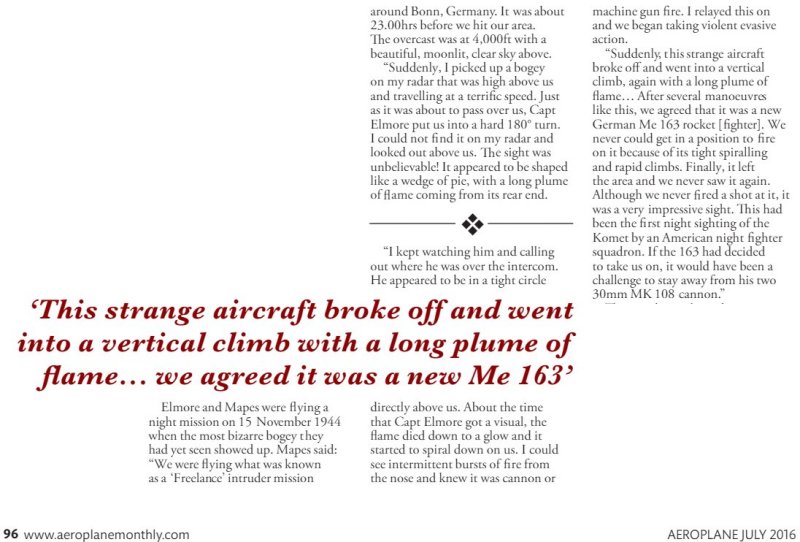
|
'This strange aircraft broke off and went into a vertical climb with a long plume of flame... we agreed it was a new Me 163'
Elmore and Mapes were flying a night mission on 15 November 1944 when the most bizarre bogey they had yet seen showed up. Mapes said:
“We were flying what was known as a 'Freelance' intruder mission around Bonn, Germany. It was about 23.00 hrs before we hit our area. The overcast was at 4,000ft with a beautiful, moonlit, clear sky above.
“Suddenly, I picked up a bogey on my radar that was high above us and travelling at a terrific speed. Just as it was about to pass over us, Capt Elmore put us into a hard 180° turn. I could not find it on my radar and looked out above us. The sight was unbelievable! It appeared to be shaped like a wedge of pie, with a long plume of flame coming from its rear end.
“I kept watching him and calling out where he was over the intercom. He appeared to be in a eight circle directly above us. About the time that Capt Elmore got a visual, the flame died down to a glow and it started to spiral down on us. I could see intermittent bursts of fire from the nose and knew it was cannon or machine gun fire. I relayed this on and we began taking violent evasive action.
“Suddenly, this strange aircraft broke off and went into a vertical climb, again with a long plume of flame... After several manoeuvres like this, we agreed that it was a new German Me 163 rocket (fighter). We never could get in a position to fire on it because of its tight spiralling and rapid climbs. Finally, it left the area and we never saw it again. Although we never fired a shot at it, it was a very impressive sight. This had been the first night sighting of the Komet by an American night fighter squadron. If the 163 had decided to take us on, it would have been a challenge to stay away from his two 30mm MK 108 cannon.”
[Ref. fjl1:] "FLIGHT JOURNAL" MAGAZINE:
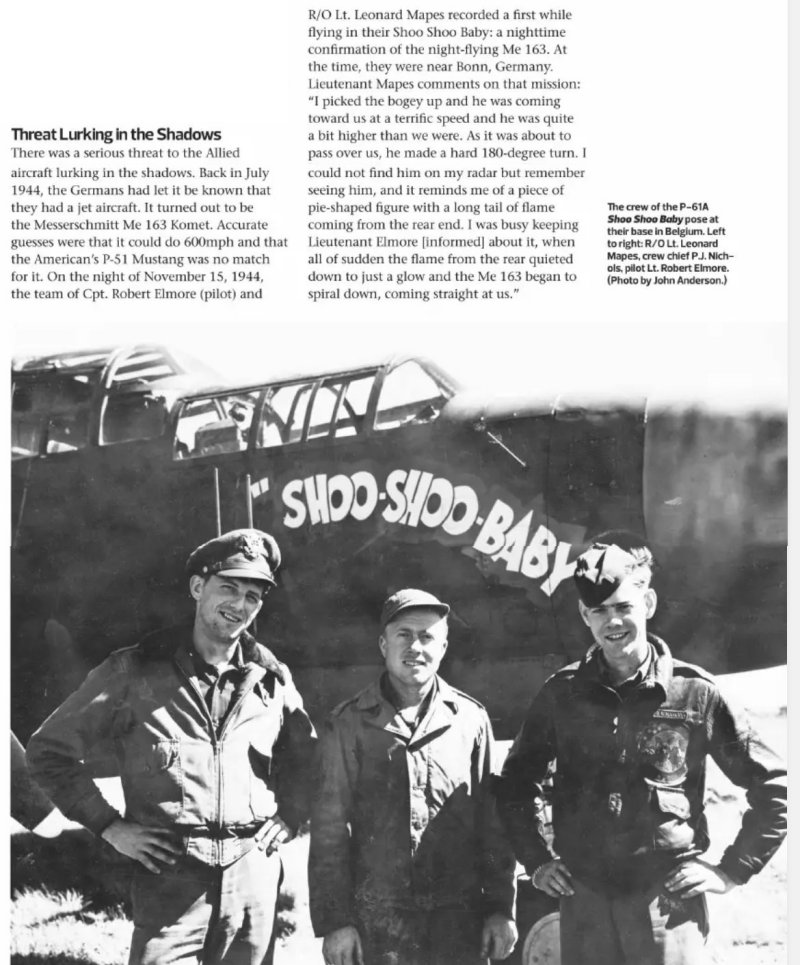
|
There was a serious threat to the Allied aircraft lurking in the shadows. Back in July 1944, the Germans had let it be known that they had a jet aircraft. It turned out to be the Messerschmitt Me 163 Komet. Accurate guesses were that it could do 600mph and that the American's P-51 Mustang was no march for it. On the night of November 15, 1944, the team of Cpt. Robert Elmore (pilot) and R/O Lt. Leonard Mapes recorded a first while flying in their Shoo Shoo Baby: a nighttime confirmation of the night-flying Me 163. At the time, they were near Bonn, Germany, Lieutenant Mapes comments on that mission:
“I picked the bogey up and he was coming toward us at a terrific speed and he was quite a bit higher than we were. It was about to pass over us, he made a hard 180-degree turn. I could not see him on my radar but remember seeing him, and it reminds me of a piece of pie-shaped figure with a long tail of flame coming from the rear end. I was busy keeping Lieutenant Elmore (informed) about it, when all of sudden the flame from the rear quieted down to just a glow and the Me 163 began to spiral down, coming straight at us.”
[Photo caption:] The crew of the P-61A Shoo Shoo Baby pose at their base In Belgium. Left to right: R/O U. Leonard Mapes, crew chief P J. Nichols, pilot Lt. Robert Elmore. (Photo by John Anderson.)
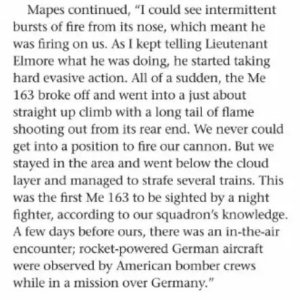
|
Mapes continued, “I could see intermittent bursts of fire from its nose, which meant he was firing at us. As I kept telling Lieutenant Elmore what he was doing, he started taking hard evasive action. All of a sudden, the Me 163 broke off and went into a just about straight up climb with a long tail of flame shooting out from its rear end. We never could get into a position to fire our cannon. But we stayed in the area and went below the cloud layer and managed to strafe several trains. This was the first Me 163 to be sighted by a night fighter, according to our squadron's knowledge, few days before ours, there was an in-the-air encounter; rocket-powered German aircraft were observed by American bomber crews while in a mission over Germany.”
The Northrop P-61 “Black Widow” was a high performance American night fighter plane used in WWII.
It was twin-engine, with a maximum speed of 589 km/h, 3,060 km range. The crew was of three men.
It was equipped with a radar and armed with 4 Hispano 20 mm cannons in the fuselage and 4 Browning M2 12.7 mm machine guns in the remotely controlled upper turret.
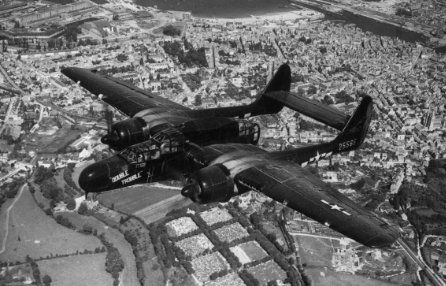
|
Above: a P-61 of the 422d Night Fighter Squadron in 1944.
Some versions of the P-61 had an upper turret with 4 remote-controlled machine guns. This was not the case with Elmore and Maple's plane (See below). This explains that to fire at the Me-163, they would have had to use fixed machine guns and therefore aim at their enemy, which they were not able to do, according to their report.
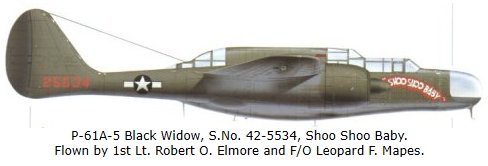
|
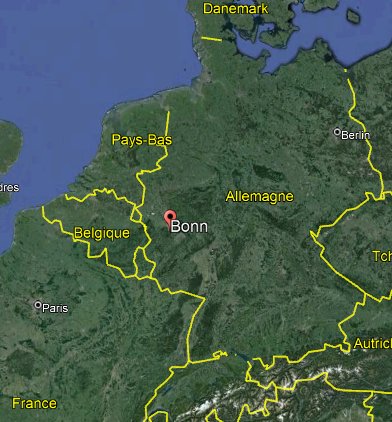
|
The Messerschmitt Me-163 Komet (Comet) (photo below) was designed by Alexander Lippisch, and was the only operational rocket-propelled fighter plane in History. The first flight took place on August 13, 1941, and the first operational use was in May 1945. Its last flights in the War were in February 1945.
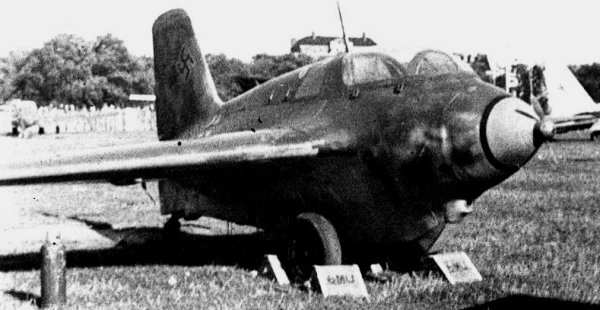
|
The Me-163 was basically a glider, with wings made of wood, fitted with a rocket engine and two 30 mm guns.
On October 2, 1941, a Me-163 reached the record speed of 1004 km/h. The climb rate was exceptional. But it was handicapped by a firing system whose rate was too slow, by the difficulty of adjusting the aim given the speed, by the tendency to explode on takeoff, and by a flight autonomy of only 7 min 30 seconds before fuel ran out.
It was especially vulnerable on the ground and in the descent and landing phase which was done by gliding flight after exhaustion of fuel.
The impact in the War was negligible; the 279 Me-163 delivered to the Luftwaffe only destroyed 16 Allied bombers, whereas 80% of the Me163 losses were due to landings and takeoffs accidents, generally fatal for the pilots.
The Me-163 encountered by Mapes and Elmore was likely operating from the Venlo airfield in the Netherland, on the German border, 77 km northwest of Bonn (The range of a Me-163 flight was about 100 km). It was a night fighter base of the Luftwaffe that briefly housed the 2./JG400 Me-163 night fighters unit. The Allied forces occupied Venlo on March 1, 1945.
The plane in this mission was the P-61A-5-NO 42-5534 “Shoo-Shoo-Baby”, contruction number #766, crewed by Lt Robert O. Elmore and Radar Officer Lt Leonard F. Mapes, of 422nd Night Fighter Squadron of the U.S. Army Air Forces, based in Chateaudun, France, at the time of the encounter.
On July 16-17, 1944, they destroyed a V-1 flying bomb in flight in the Beachy Head area.
Their planed crash landed, with damages beyond repair, due to bad weather at Le Culot, Belgium, on December 19, 1944, but Elmorand Mapes were unhurt.
Photo below: Robert Elmore, left and Leonard Mapes near their P-61.
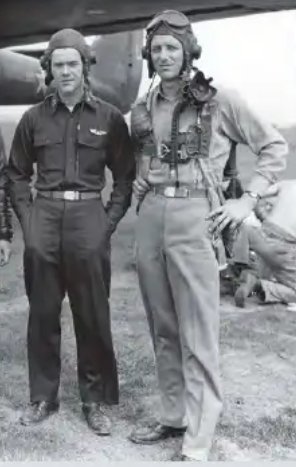
|
The most important point here is that unlike what appeared to be suggested by Lindell, what Elmore and Mapes encountered was readily identified, during the mission. To them, it was clearly not some “mysterious” “ball of light”, but a Me-163; which they described very accurately in its shape, in its maneuvers, his weaponry, its rocket engine.
Mapes saw the contour of the Me-163: “It appeared to be shaped like a wedge of pie...” This fits the Me-163 in a spiralling descent to the P-61, showing its shape in a bank.
Mapes saw, not a “luminous ball”, but “a long plume of flame coming from its rear end.” This is what is seen when the rocket engine is on, during the approaches and climbs of course. Mapes saw when the engine was cut by the Me-163 pilot: “the flame died down to a glow and it started to spiral down on us.”
Below: the rocket engine trail of the Me-163 can hardly be called a “luminous ball”.
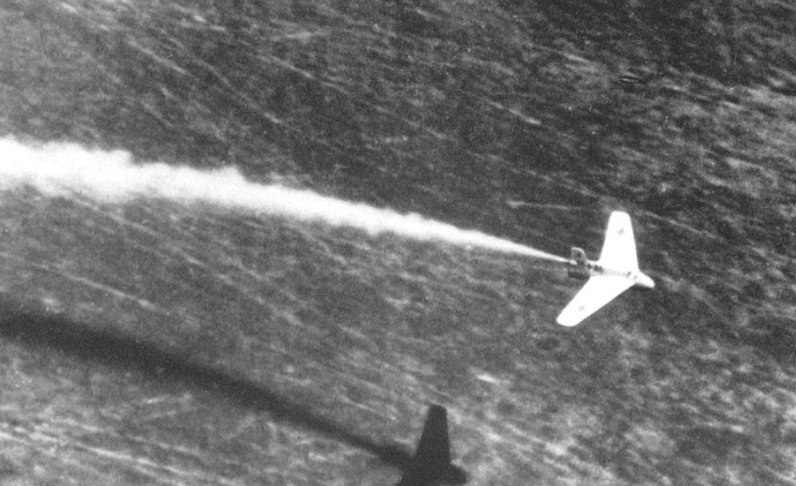
|
The report is totally different from the “Foo-Fighters” reports.
Another difference is that in the “Foo-Fighters” reports, these “things” never attacked to Allied planes. They sometimes followed, sometimes maneuvered, sometimes followed the Allied planes despite the violent evasive actions, but they did not fire; whereas in this report, the Me-163 fired.
If this Me-163 encounter had started a rumor among the Allied night fighters crew, for example among the 415th NFS crew who reported most of the “Foo-Fighters” over the Rhine Valley in 1944-1945, then, these pilots would have claimed that they, too, saw German Messerschmitt Me-163 Komets, rather than “Foo-Fighters”, the term they coined about this unidentified phenomena. Thus, the Elmore and Mappes Me-163 encounter did not “make” other pilots “see” Foo-Fighters, on the contrary, they would know from this rumor that there were Me-163 in the skies, and if an “influence” had been exerted by the “rumor”, they would have claimed to have encountered Me-163's.
Night flights of Messerchmitt Me-163 were normally not performed. This craft had to land on a skid after gliding back down to the airfield. Doing this by night would be very risky. But here, we did have a night flight. This may be an argument for Me-163 night flights as explanation of “Foo-fighter” cases. But the context is important. Mapes clearly gave it in his report: “a beautiful moonlit clear sky above.” This of course made the Me-163 night flight and subsequent landing much less risky. But why would this Me-163 pilot perform this flight?
We are near the end of WWII and the Germans were desperately trying new tactics to get rid of the Allied planes. They started to use the Messerchmitt Me-262 jet plane as a night fighter, with a two-seater, radar-fitted new version. Very possibly, they did some night flight tests with the Me-163 also, in order to determine if this rocket plane too, could be used as a night fighter, at least under moonlit clear skies.
Negative case, Me-163 German rocket plane.
* = Source is available to me.
? = Source I am told about but could not get so far. Help needed.
| Main author: | Patrick Gross |
|---|---|
| Contributors: | None |
| Reviewers: | None |
| Editor: | Patrick Gross |
| Version: | Create/changed by: | Date: | Description: |
|---|---|---|---|
| 0.1 | Patrick Gross | July 12, 2024 | Creation, [wtn1], [jll1], [aem1], [fjl1]. |
| 1.0 | Patrick Gross | July 12, 2024 | First published. |